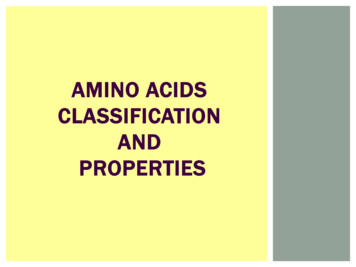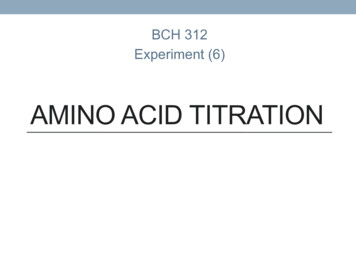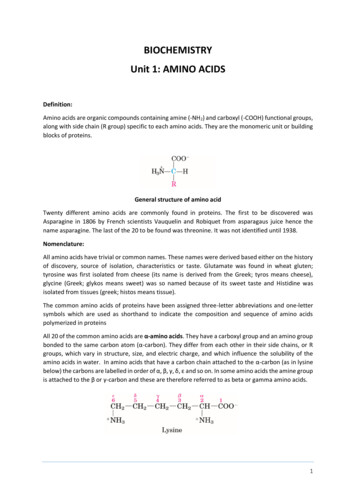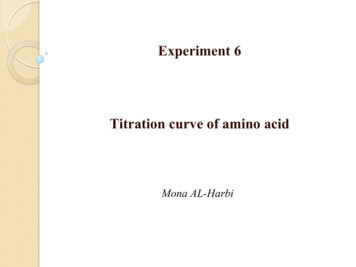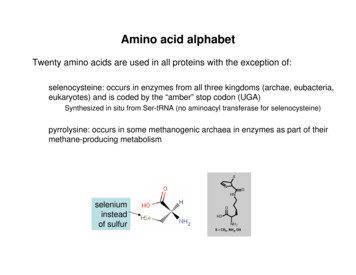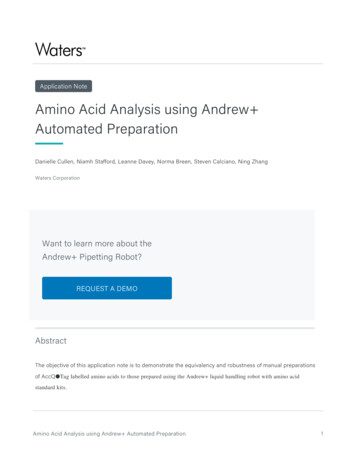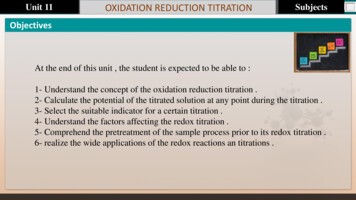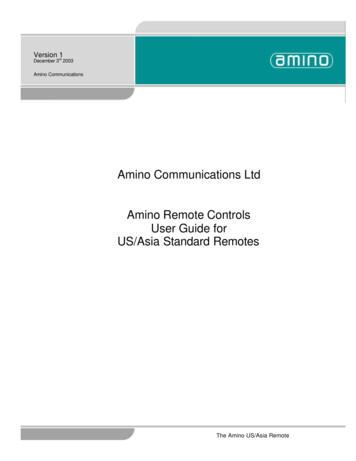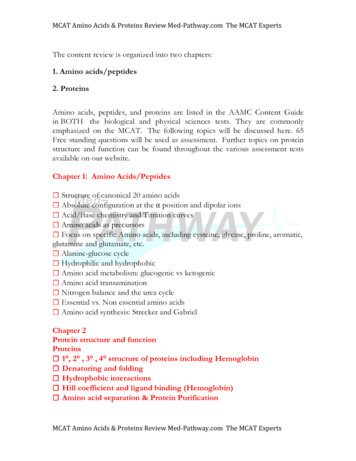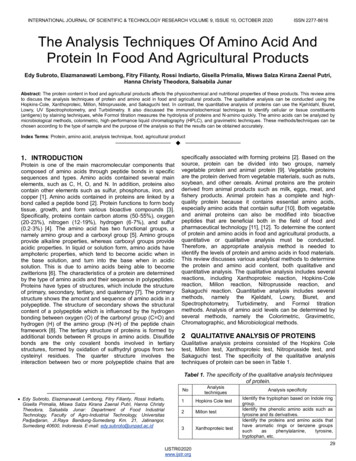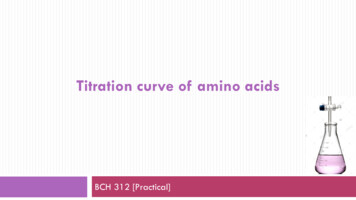
Transcription
Titration curve of amino acidsBCH 312 [Practical]
Titration curve Titration Curves are produced by monitoring the pH of a given volume of a samplesolution after successive addition of acid or alkali. The curves are usually plots of pH against the volume of titrant added (acid or base). Each dissociation group represent one stage in the titration curve.
Amino acid general formula:Amino acids consist of: A basic amino group ( —NH2 ) An acidic carboxyl group ( —COOH) A hydrogen atom ( —H) A distinctive side chain ( —R).
Titration of amino acid: When an amino acid is dissolved in water it exists predominantly in the isoelectric form. Amino acid is an amphoteric compound It act as either an acid or a base: Upon titration with acid it acts as a BASE (accept a proton). Upon titration with base it acts as an ACID (donate a proton)
Amino acids are example of weak acid which contain more than one dissociate group. Examples:(1) Alanine:-Contain COOH (pKa1 2.34) and NH3 (pKa2 9.69) groups (it has one pI value 6.010). [Diprotic]-The COOH will dissociate first then NH3 dissociate later . (Because pKa1 pKa2)Full protonated alanine(2) Arginine:-Contain COOH (pKa1 2.34) , NH3 (pKa2 9.69) groups and basic group (pKa3 12.5)(it has one pI value 11). [Triprotic]
Titration curve of Alanine9X7X6X5X4X1X2X3X8X2.349.69
Titration curve of alanine or glycine [diprotic]:[1] In starting point: Alanine is full protonated. [NH3 -CH-CH3-COOH].[2] COOH will dissociate first: [NH3 -CH-CH3-COOH] [NH3 -CH-CH3-COO-] pH pKa1.[3] In this point the component of alanine act as buffer: [NH3 -CH-CH3-COOH] [NH3 -CH-CH3-COO-].pH pKa1
Cont.[4] In this point:[NH3 -CH-CH3-COOH] [NH3 -CH-CH3-COO-].pH pKa1.[5] Isoelectric point:The COOH is full dissociate to COO-.[NH3 -CH-CH3-COO-] .Con. of -ve charge Con. of ve charge.The amino acid present as Zwetter ion (neutral form) .Remember that :PI (isoelectric point) is the pH value at which thenet charge of amino acid equal to zero.pI (pKa1 pKa2) /2 (2.32 9.96)/2 6.01[6] The NH3 start dissociate:[NH3 -CH-CH3-COO-] [NH2-CH-CH3-COO-].pH pKa2.
Cont.[7] In this point the component of alanine act as buffer:[NH3 -CH-CH3-COO-] [NH2-CH-CH3-COO-] .pH pKa2.[8] In this point:[NH3 -CH-CH3-COO-] [NH2-CH-CH3-COO-] .pH pKa2[9] End point:The alanine is full dissociated.[NH2-CH-CH3-COO-]pOH (pkb P[A-])/2 pKb pKw – pKa2
Calculating the pH at different point of the titration curve :The pH calculated by different way :[1] at starting point :pH (pka P[HA])/2[2] At any point within the curve (before or in or after middle titration):pH pka log([A-]/[HA])[3] At end point:pOH (pKb P[A-])/2pH pKw – pOHpKb pKw – pKa2
Practical Part
Objectives To study titration curves of amino acid. To use this curve to estimate the pKa values of the ionizable groups of the amino acid. To determine pI. To determine the buffering region. To understand the acid base behaviour of an amino acid.
Method:a)You are provided with 10 ml of a 0.1M alanine solution, titrate it with 0.1M NaOH adding thebase drop wise mixing, and recording the pH after each 0.5 ml NaOH added until you reach apH 11.Measured pH valuea)Amount of 0.1M NaOH added [ml]Take another 10 ml of a 0.1M alanine solution, titrate it with 0.1 M HCL adding the acid drop wisemixing, and recording the pH after each 0.5 ml HCL added until you reach a pH 2.17.Measured pH valueAmount of 0.1M HCl added [ml]
Results Record the titration table and plot a curve of pH versus ml of titrant added. Calculate the pH of the alanine solution after the addition of 0 ml, 5ml, of 0.1M NaOH, and calculatepH after addition of 0.5 ml , 2ml of HCl. Determine the pKa of ionizable groups of amino acids. Determine the PI value from your result Compare alanine pka and pI values with those obtained from Curve. Compare your calculated pH values with those obtained from Curve. Determine the buffering points.
Titration curve of alanine with 0.1M NaOH131211109pH876543210012345678910 11 12 13 14 15 16 17 18 19 20 21ml of NaOH
Note: in calculating the pH: At any point within the curve pH pka log([A-]/[HA])If a base is added:If acid is added:The amino acid will betreated as an acidThe amino acid will betreated as a baseThe pKa used is of theamine group.The pKa used is of thecarboxyl groupThe upper stageThe lower stage
Titration of amino acid: When an amino acid is dissolved in water it exists predominantly in the . isoelectric form. Amino acid is an . amphoteric. compound It act as either an acid or a base: Upon titration with acid it acts as a BASE (accept a proton). Upon titration with base it acts as an ACID (donate a proton)
